Evaluating regulations, subsidies, pricing mechanisms, and hybrid policies
Abstract:
There is a growing recognition among businesses, policymakers, and the general public regarding the economic and societal risks of climate change. The latest, most urgent call to action from the IPCC has increased attention on policies to reduce CO2 emissions and enhance carbon sequestration. Finding agreement on a specific policy is complicated by diverse sectoral impacts, low policy experience, and fragmented action at the state and federal levels.
This article provides a primer on the three major policy building blocks available for reducing carbon pollution: pricing mechanisms, subsidies, and regulations. The article discusses the various policies and how they can be combined together to create hybrid policies with some examples drawing on Washington state provided.
Executive Summary:
Pricing Mechanisms: Pricing carbon is the most economically efficient way to reduce carbon emissions because the marketplace is more flexible and entrepreneurial than government programs. In its simplest form, a carbon tax or fee reduces emissions due to the elasticity effect. When the price of a commodity like oil goes up, consumers buy less of it. Pricing mechanisms promote conservation, efficiency improvements, and fuel switching, while encouraging investment in new cleantech innovations. On the other hand, pricing mechanisms steeply discount future costs and hence don’t accurately guide society towards long term goals.
A broad economy and world-wide pricing mechanisms with few exemptions would be the most economically efficient policy. When a state or region acts alone border adjustments or exemptions are needed to maintain fairness for instate producers who compete in regional or global marketplaces in order to avoid creating a competitive disadvantage which risks transferring jobs out-of-state without any net pollution reduction. Pricing mechanisms alone are also regressive as energy costs represent a greater percentage of low-income individuals annual income. Additionally low-income individuals are less capable making the upfront payment for new more efficient vehicles, homes and technology even if they know it will save them money over its expected life. Some of the revenue from a carbon pricing mechanism should be allocated to offset this regressive impact.
Probably the biggest challenge to making a meaningful policy impact with pricing mechanisms is they aren’t popular. This is especially true at the most impactful levels, such as Sweden’s $170/ton or Switzerland’s $200/ton price.
- Washington’s failed I-732 – a revenue neutral carbon tax initiative was a pure pricing mechanism in that it was non-regulatory and didn’t fund any subsidy programs.
Subsidies: Subsidies are generally the least economically efficient way to reduce carbon emissions due to the administrative burden of running grant programs and the need to accurately subsidize winners on a technology, project, or sector specific basis. Over the long-term, specific technology subsidies run the risk of blocking innovation and creating barriers to entry. However, subsidies can help highly valuable technologies reach economies of scale and full commercialization. Subsidies may also create market movement where pricing mechanisms are not likely to overcome specific barriers to deployment. The impact of subsidy programs can be enhanced per allocated dollars by leveraging private funds with grant matching programs. Even though subsidies offer lower overall economic efficiency, a lot of carbon reductions can be purchased at reasonable prices by a well-run grant program. Providing economic carrots to promising technologies is generally the most popular approach – however raising revenue to cover the costs of subsidies runs into many of the same conflicts as carbon pricing.
- Washington’s failed I-1631 – a carbon fee and invest initiative was a hybrid policy combining a pricing mechanism with subsidy programs.
Regulation: The most effective carbon reduction policy option is regulation. A declining cap on total CO2 emissions provides greater certainty that reduction goals will be achieved, and market certainty can create very economically efficient reductions. The challenge is the uncertainty regulations can also create around the cost of compliance. For a narrow regulation, such as requiring catalytic converters on all cars, costs may be relatively easy to estimate. A declining cap on fossil fuel consumption has a much larger set of unknowns regarding technology, resources, and other shifts that could affect the cost of compliance. Businesses often express concern about carbon regulations due to the price uncertainty which makes long-term planning more difficult. The public, however, favors regulations, perhaps as a way to assign environmental problems to government that can design a solution using a deliberative process with less apparent costs, rather than accept a carbon tax that is perceived as more immediately impactful to their personal activities.
- The Clean Air Rule is an example of a regulator policy, as was HB 2995, which would impose a 100% Clean Electricity Standard on the electric sector.
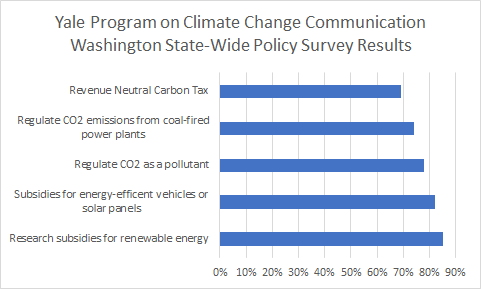
Chart 1 – Comparing Yale Climate survey results for Washington State support for specific policies
Hybrid Policies: Pricing, subsidies, and regulations need not be stand-alone policies, but can be building blocks which are combined together to create hybrid policies tailored to different sectors, regions, or sources of emissions. A well-designed hybrid policy can seek to pull on the strengths of one policy option while minimizing the weaknesses of others. Examples of hybrid policies include:
- Washington’s 2017 introduced HB 2338 – Carbon Fuel Standard bill is a technology agnostic hybrid combining a regulatory requirement with a pricing mechanism affecting transportation fuels.
- Washington’s voter approved Renewable Portfolio Standard is a technology specific hybrid combining a regulatory requirement with a pricing mechanism within the electric sector.
- California’s Cap and Trade Program – AB32 is a hybrid combining all three policies creating a regulatory pricing mechanism that funds subsidy programs.
Pricing Mechanisms:
In general, it is more economically efficient to tax something unwanted than it is to try and subsidize a particular solution to the problem. In some cases, pricing has a strong effect, such as commodities with many substitutes, making these “elastic”. In other cases where fewer practical lower cost alternatives exist, the demand for a commodity is “inelastic.” The same elasticity effect applies to pollution. A cost on emitting carbon pollution into the atmosphere causes businesses and consumers to reduce activities that cause carbon pollution via conservation, efficiency, and substitution with alternative energy sources.
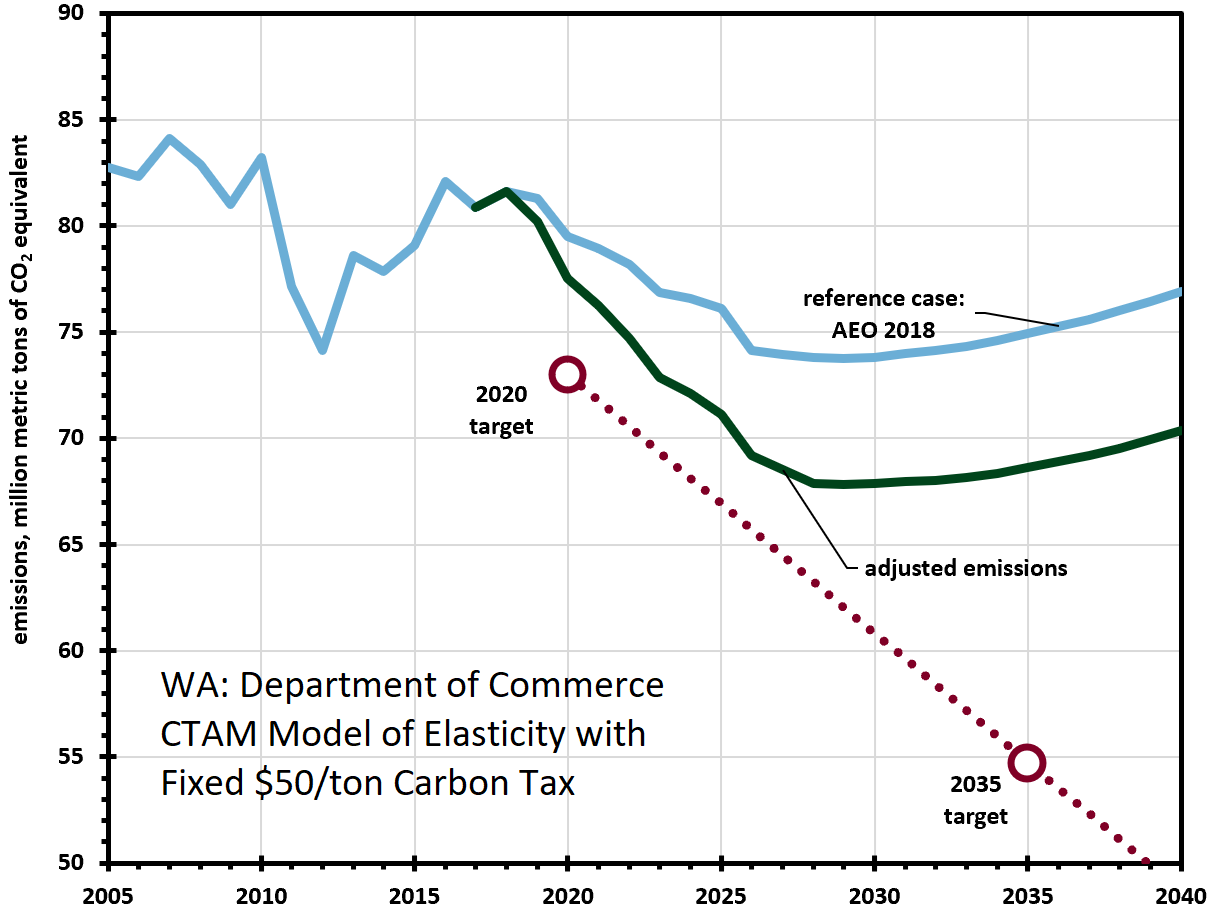
Chart 2 – Washington State Department of Commerce Carbon Tax Assessment Model (CTAM) comparing business as usual emissions to the elasticity effects of a carbon tax of $50/ton.
Economists argue that Pigouvian taxes, like a carbon tax, are the most economically efficient means of reducing pollution. This is because taxes on pollution create a direct financial disincentive to pollute and provide a broad reaching market mechanism that is technology agnostic. Carbon taxes and other pigouvian taxes, or sin taxes, on cigarettes and alcohol are rare examples of potentially beneficial taxes that can create more economic gains for society as a whole than the deadweight economic drag the taxes themselves create. By contrast, income, property, and sales taxes create a deadweight drag on the economy while simultaneously reducing desirable things: income, property, and the sale of goods.
Carbon taxes can be beneficial to an economy. Emitting carbon pollution causes local air pollution and health costs plus the economic damages from storms, crop-loss, forest fires, rising sea-levels, ocean acidification, spread of disease and other issues. Impact analysis of carbon taxes going before a public vote often ignore these avoided economic damages, and focus primarily on the cost the consumer pays at the pump or utility. These real health and environmental costs not currently included in the purchase price of fossil fuels are commonly referred to as the social cost of carbon. Until a carbon tax exceeds the social cost of carbon, the economic losses it creates will be more than offset by the economic benefit of the avoided damages it creates.
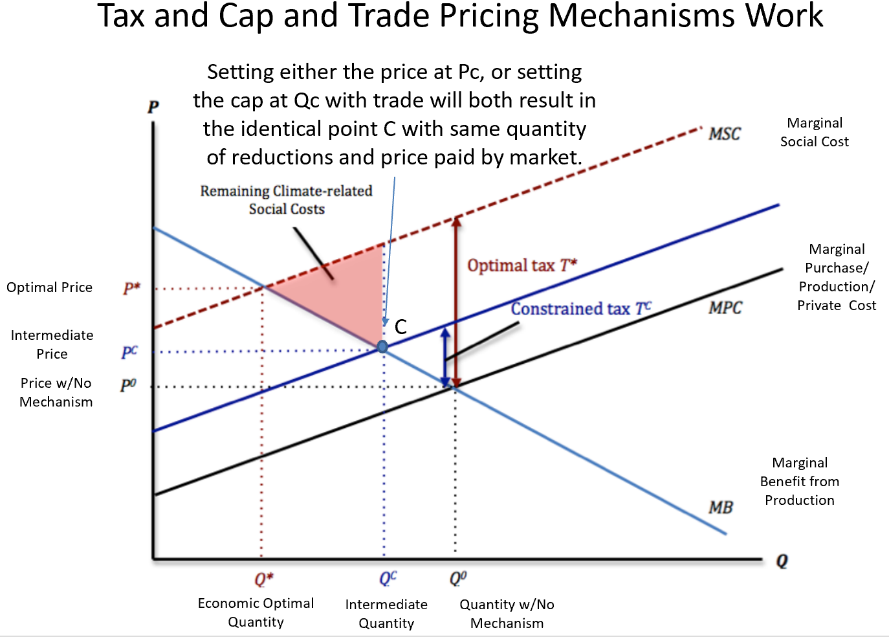
Chart 3 – An idealized cap and trade program with no administrative losses will achieve the identical quantity of reduction for a specific price as a carbon tax. Whether you lead with quantity changes, or with price changes, the same shift in marginal purchase costs relative to marginal benefits occurs.
In a perfect marketplace with perfect forward-looking information, the exact social cost of carbon would be known. The social cost could then be internalized into the price associated with engaging in carbon emitting activities like burning gasoline. Consumers would continue using hydrocarbon fuels, but to a lesser degree because the price of purchasing those commodities would reflect the total damages burning them creates for society as a whole. Today we do not internalize these external costs, which creates a tragedy of the commons and a perverse incentive for environmental degradation in an effort to maximize profits.
The actual reduction of carbon pollution from a price on carbon comes from four main categories:
- Innovation – Often undervalued, Innovation is perhaps the biggest long-term advantage to a price on carbon. Entrepreneurs and inventors respond to economic incentive. Currently there is no cost applied on fossil fuels in Washington to specifically capture the external costs of carbon emissions. With no price applied to carbon emissions, products and services that offer lower carbon emissions do not receive compensation for the environmental benefits they create.
- Conservation – Individuals and businesses will respond to higher prices by driving less, flying less, turning lights off more often, turning down their thermostats, and engaging in other activities that reduce hydrocarbon fuel consumption. Conservation measures are often easy, generally have no upfront capital costs, and save businesses and consumers money.
- Efficiency – Rational businesses, municipalities, and individuals examine life cycle costs of facilities and equipment when investing in new cars, furnaces, buildings, and other infrastructure projects. A price on carbon increases the operating costs associated with burning fossil fuels, shifting the purchase decision towards more efficient options. Many investments made today will last over a hundred years and will cause economic losses if purchased using incorrect assumptions about their long-term operating costs.
- Fuel switching – Not all forms of energy are equal in terms of the carbon pollution they create. Regardless of changes in specific commodity prices, carbon pricing creates a constant forcing factor that levels the playing field between hydrocarbon and low-carbon energy. Regardless of the current price of oil, natural gas, or coal, with a carbon tax in place biofuels and renewable energy are more cost competitive with than without a carbon tax.
The failed 2016 revenue neutral carbon tax, Initiative 732, was a pure pricing mechanism. I-732 directed all of its revenue towards reducing other existing taxes and had no other regulatory or subsidy mechanism to motivate carbon reductions.
In 2017, the Washington State legislature investigated the idea of using a carbon tax to pay for a court ordered increase in K-12 education funding. If these were the only two elements of a policy, that also would be a pure pricing mechanism policy; even though the carbon tax would have been revenue generating. To fund K-12 education, the Washington State legislators instead increased property taxes which puts economic drag on land owners to fund the benefit of improving K-12 education. A carbon tax below the social cost of carbon could fund K-12 education while also reducing the economic damages of pollution. Carbon taxes can deliver a rare win-win situation while conventional taxes almost always deliver at best a win-lose.
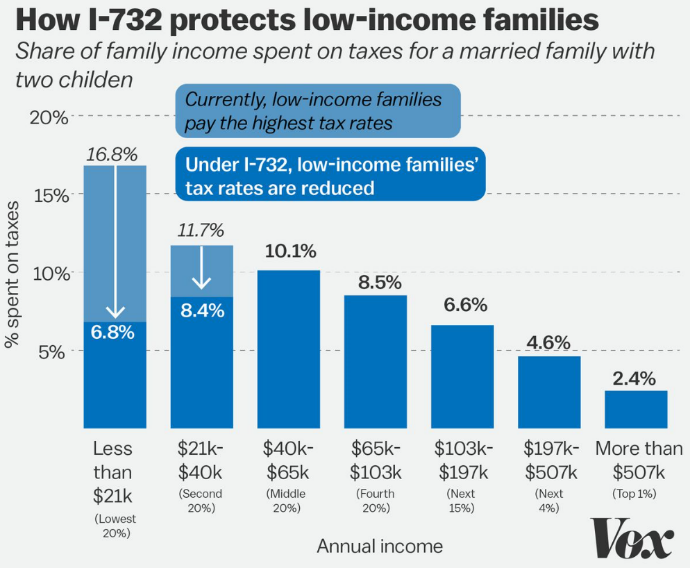
Chart 4 – An example of how a state expansion of the federal working family tax rebate was integrated into the I-732 policy design to reduce the regressivity of Washington’s tax code.
Although offering system wide benefits, carbon taxes are regressive and disproportionately impact many who are not in the position to quickly adjust behavior. This same problem arises with a sales tax and other consumption based forms of taxation. Even though the wealthy burn more energy and end up paying the bulk of the carbon tax, low income households will pay a greater percentage of their annual income towards the carbon tax. This is especially challenging for Washington State which is already regarded as the most regressive tax system in the nation. All good pricing mechanisms should seek to offset this regressive impact by offsetting the disproportional financial burden placed on low-income households by a price on carbon. The use of revenue can also emphasize generating benefits for disproportionately impacted communities.
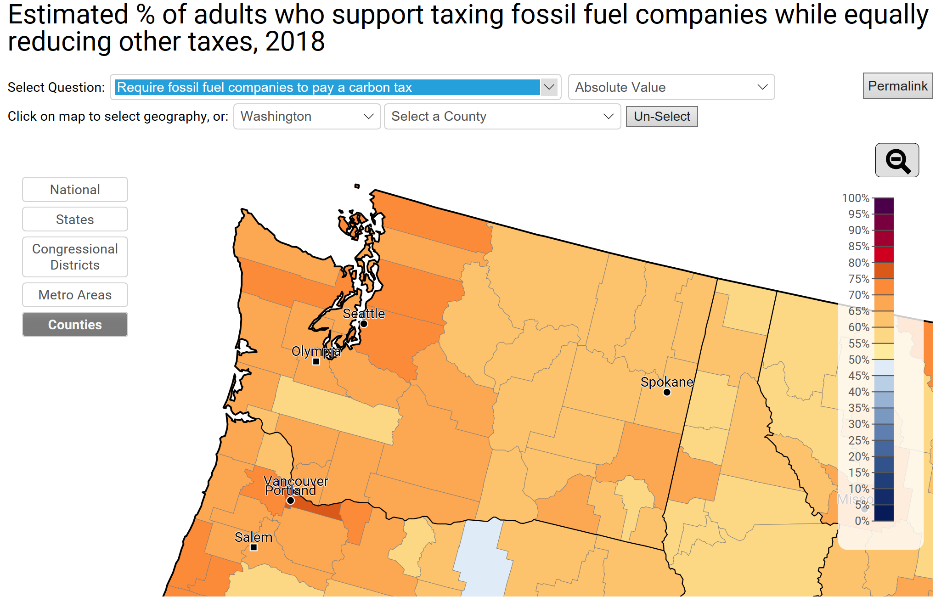
Chart 5 – Support for a revenue neutral carbon tax in the 2018 Yale Program on Climate Change Communications poll is at 68% nationally, and 69% in Washington State.
The functional challenge with carbon pricing is ironically its policy strength. The price is directly applied to and apparent to the consumers of energy while the benefits are distributed among society as a whole. For this reason, it is very difficult to pass a carbon tax by public vote because individuals and businesses can easily recognize the direct costs it will impose upon them. The greater health savings and economic benefits society as a whole would receive as a result of the policy are much less tangible to the individual than the costs.
Subsidies:
A far more popular policy method everywhere in the United States is to subsidize emerging technologies with direct financial rewards. The public is much less excited about paying for the damage they create than subsidizing a flashy new technology. Support for subsidizing renewable energy research transcends both parties, with 85% support nationally. Subsidies in the form of tax rebates for efficient vehicles and for solar has national support levels of 82%, and no less than 77% in any Washington county or congressional district.
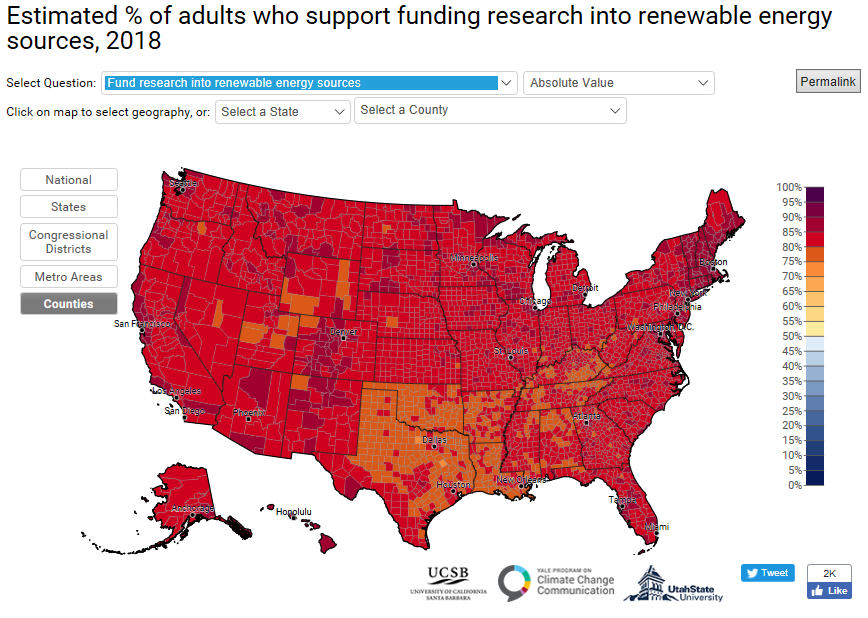
Chart 6 – Support for research subsidies for renewable energy in the 2018 Yale Program on Climate Change Communications poll is at 85% nationally and in Washington State.
The risk with subsidies is they are generally programs targeting specific technologies that are perceived, at least initially, to be good investments In reality chosen technologies may be popular but inefficient or ineffective approaches to tackling the problem. Subsidies are the opposite of a technology agnostic/neutral market mechanism. Unfortunately, subsidy programs have a mediocre track record for picking and choosing winners. There is a risk that subsidy funds will go towards a technology that flops and creates no carbon reductions, or that popular but expensive existing technologies use up funds and displace more cost-effective investments that could have reduced more carbon pollution with the available funds.
Technology specific subsidies also distort the marketplace, slowing down innovation and the emergence of a competing but superior technology. It can be argued that subsidies for hydrogen powered vehicles slowed the emergence of battery electric vehicles. Fossil fuels have historically received, and continue to receive, substantial subsidies that have helped them establish, grow and retain market share while blocking cleaner competitors. Closer to home you can argue that Washington’s production incentive program for rooftop solar photovoltaic panels has decreased the quantity of rooftop solar hot water systems. They may have also prevented the innovative manufacturing of combined PV plus thermal panels now showing up in other marketplaces because the production of electricity from the sun is subsidized in Washington but the production of hot water from the sun is not. Unintended consequences and market disruptions in general are higher risks for technology specific policies compared to broad market driven policies.
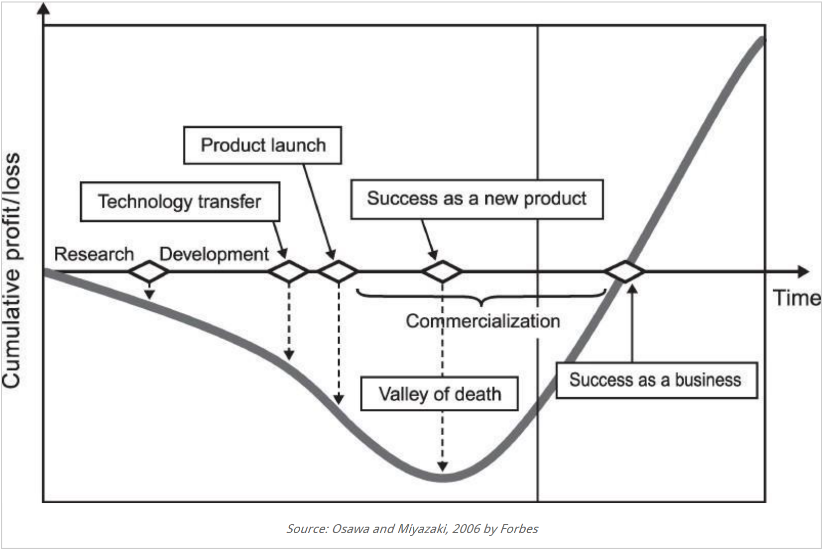
Chart 7 – Illustration of the research, development, and commercialization cycle for most technologies.
There are situations where subsides make sense; and not just because they are easier to pass into law than pricing mechanisms. The main reason to subsidize a technology is to allow a beneficial technology to reach the appropriate economies of scale, overcoming what is called the valley of death. Most technologies follow what are called learning or experience curves. The greater the volume of total production, the cheaper producing an additional unit becomes. A product which may not be cost effective today could become cost effective in the future once millions of units have been produced and the cost of production declines. Subsidies can provide a bridge across the valley of death, allowing the successful commercialization of a product until it no longer require subsidies to compete.
It is generally good to subsidize a technology that is not yet cost effective today but offers huge potential upside if it becomes competitive. Solar likely falls in this category because it is the most abundant source of energy on the planet. If solar is cost competitive with fossil fuels, the economic and environmental upsides would be enormous. Solar subsidy programs around the world have successfully been increasing production and driving down costs to the point that it is believed solar generated electricity will be cheaper than electricity coming from coal and natural gas power plants.
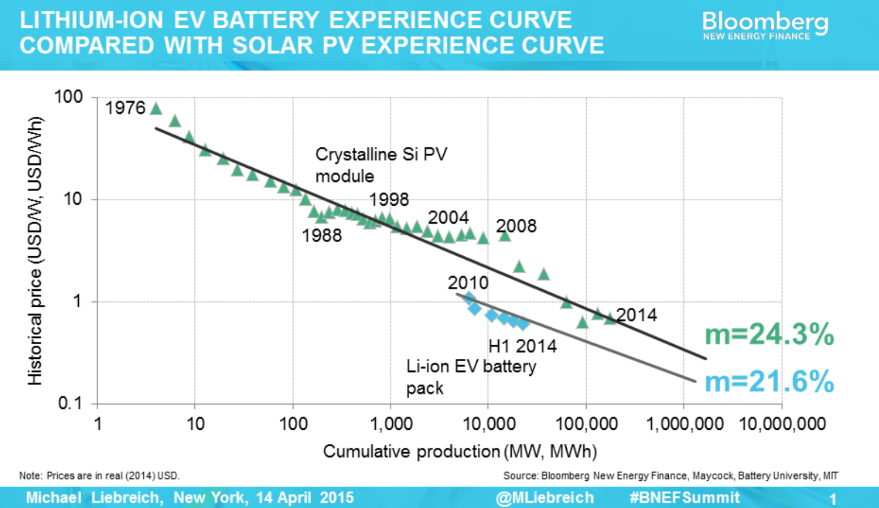
Chart 8 – Photovoltaic solar panel and electric vehicle battery pack examples of how learning curves can project declining technology costs as total cumulative production increases.
Electric Vehicles (EV) may also be worth subsidizing. EV battery technology is rapidly decreasing in price with increased production, so cost parity with internal combustion vehicles could be just around the corner. EV subsidies may be warranted because an electric vehicle is a transformative technology from an energy supply perspective – and batteries alone may be transformative for decarbonizing the power system. While there are lots of different ways to produce low-carbon electricity, there is a much smaller list of low-carbon liquid transportation fuels. Accelerating the adoption of electric vehicles greatly enhances the flexibility of where we get our future energy from by allowing a greater portion of transportation energy to come from renewable electricity rather than the limited number of renewable liquid fuel sources.
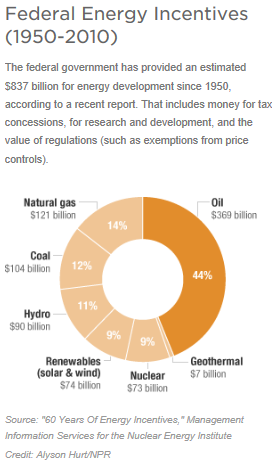
Chart 9 – A 60 year cumulative look at the value of subsidies, tax breaks, and regulatory breaks granted to different energy sectors; 70% of subsidies have gone to the fossil fuel industry.
Early stage research and development (R&D) subsidies are a potentially beneficial and popular form of subsidy. While results are very uncertain, it is a relatively low cost investment with high reward if a major technology advancement occurs. In general we are a society of learners and developers and a general policy of funding education and supporting all fields with reasonable R&D budgets could be augmented with additional R&D funds in specific fields of greater concern like energy availability and environmental degradation.
While subsidies do make sense in specific instances, and they are easier to pass into law, caution should be exercised in their application. The broader and more technology agnostic a subsidy is the less likely it is to have large economic waste associated with it. A targeted subsidy program creates excited advocates amongst the clear winners, but clear winners generally means a strong market distortion exists.
Most importantly we should never apply subsidies to established technologies that have already surpassed the “valley of death”, as this does nothing but prevent innovation, competition, and waste economic resources. Most notably we should immediately stop subsidizing the discovery, production, and consumption of fossil fuels. Fossil fuel subsidies are currently estimated to be 6.5% of our national GDP and are a distorting the marketplace creating an unfair competitive advantage for well established coal, oil ,and gas companies over start-up clean energy companies.
Regulations:
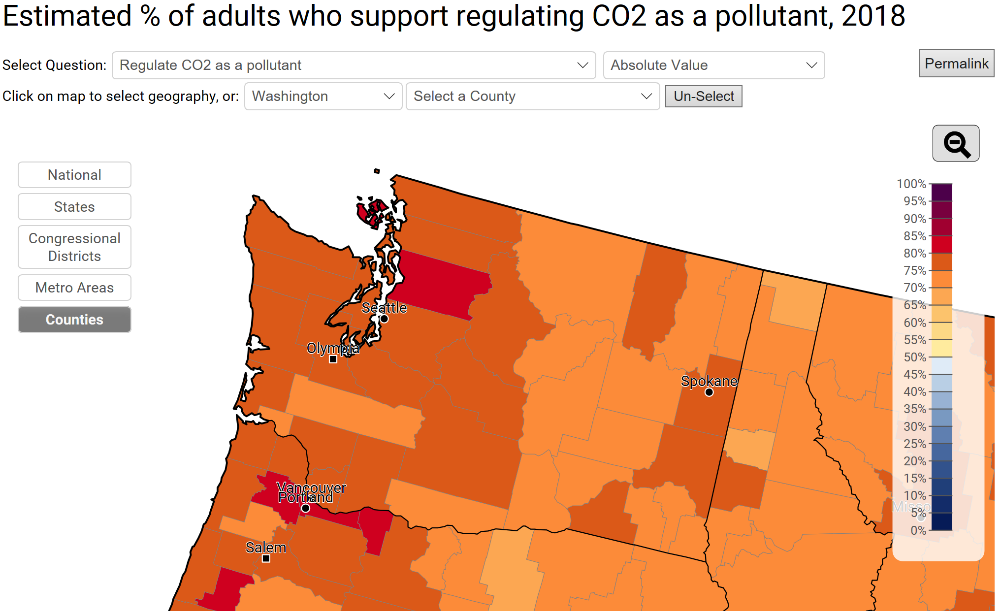
Chart 10 – Support for regulating CO2 as a pollutant in the 2018 Yale Program on Climate Change Communications poll is at 77% nationally, and 78% in Washington State
Regulations are typically the least popular mechanism for businesses, though they are more popular amongst citizens. A voter initiative that assigns regulatory authority to the Department of Ecology to reduce Washington State’s greenhouse gas emissions to a targeted level sounds cheap, or even free, compared to a carbon tax that is applied to voters personal energy use. In practice, the impacts of
such a regulation will increase prices to a similar degree as a carbon tax achieving the same result. However, most voters don’t recognize that nuance and tend to focus more on the environmental and economic benefits that reducing carbon pollution would create rather than the indirect economic personal cost it will impose on them. Regulations often sound like a simple way to address a well-known problem.
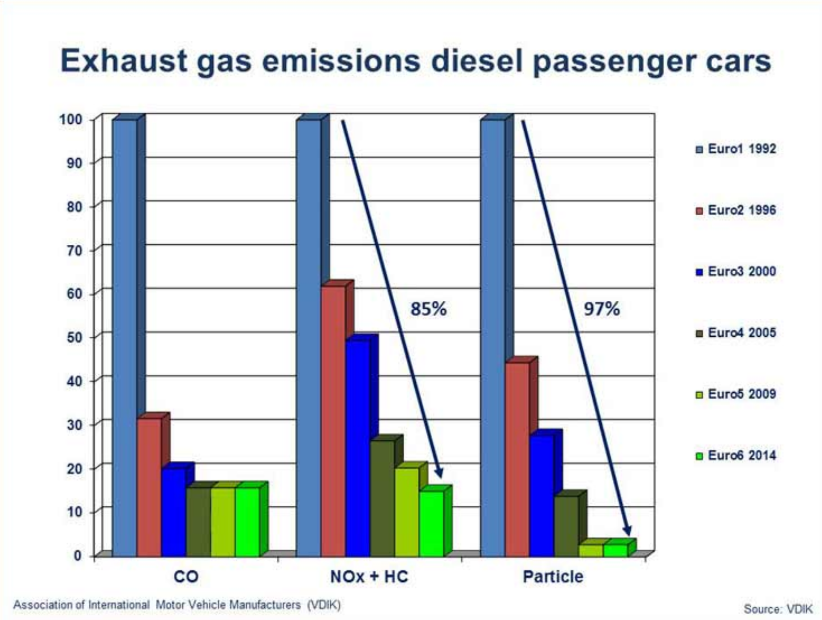
Chart 11 – European emission standards have steadily become more stringent over time. The auto industry achieves the standards and regulated pollutants per mile traveled have been greatly reduced.
Despite being criticized often by businesses and conservatives, regulations can be very economically efficient pollution reduction policies because they create a strong market signal for change. The change is required by law. A pure regulatory example is the requirement that all cars sold in the U.S. have a catalytic converter. By 1975 it became clear that the economic health benefits associated with reduced pollution far outweighed the costs of manufacturing and installing catalytic converters. It would have likely been more expensive and administratively cumbersome to develop a pricing mechanism that would have properly incentivized consumers to choose cars that had catalytic converters rather than simply mandating that that all cars had them. Regulations have also been very successfully applied to specific tailpipe emissions all around the world.
Performance standards like building codes and vehicle fuel efficiency standards are additional examples of regulations that have successfully reduced energy consumption and pollution. In general, performance standards achieve the best results if they have automatic mechanisms to increase their stringency as the marketplace often quickly achieves what were originally considered to be technologically challenging new standards.
Regulations, like subsidies, can distort marketplaces and prevent innovation. For example, very few people are working on designing something better than a catalytic converter because the barriers to entry are extremely high. A superior technology wouldn’t just need to compete on environmental performance and economic terms, but also change an entrenched regulatory policy. The challenge with regulations is their rigidity. Regulations do not adapt well to rapidly changing market conditions, technologies, or uncertainties. This risk becomes greater the more a regulation is aimed at broad market coverage rather than affecting specific sectors or technologies.
It is impossible to predict with much certainty what the future holds. That uncertainty affects the pace of technology development, the discovery of energy sources, commodity availability, the environmental costs of pollution, general economic growth, war, and other geopolitical issues. Both the strength and weakness of a regulation is its insensitivity to these external forces. No matter what is happening in the world or the marketplace, aside from repeal of the policy, the regulation drives towards a mandated outcome. That mandated outcome may come at much greater, or lower, economic cost than originally anticipated. The end result might be a higher cost than could have been achieved with a more flexible pricing mechanism. While carbon taxes are price certain, it is uncertain how much carbon reductions they will lead to, carbon regulations are reduction certain with uncertainty around the costs required to meet the regulation.
Hybrid Policies:
Pure pricing, regulatory, and subsidy policy exist around the world. However, in practice these policy building blocks are often combined together to create hybrid policies. A well-designed hybrid policy can seek to pull on specific policy strengths while minimizing other policy weaknesses.
Regulatory + Pricing Mechanisms:
Probably the most well-known hybrid climate policy is cap and trade, which is a combination of a regulation with a market mechanism that allows regulated entities to buy and sell trade-able credits as a means of compliance.
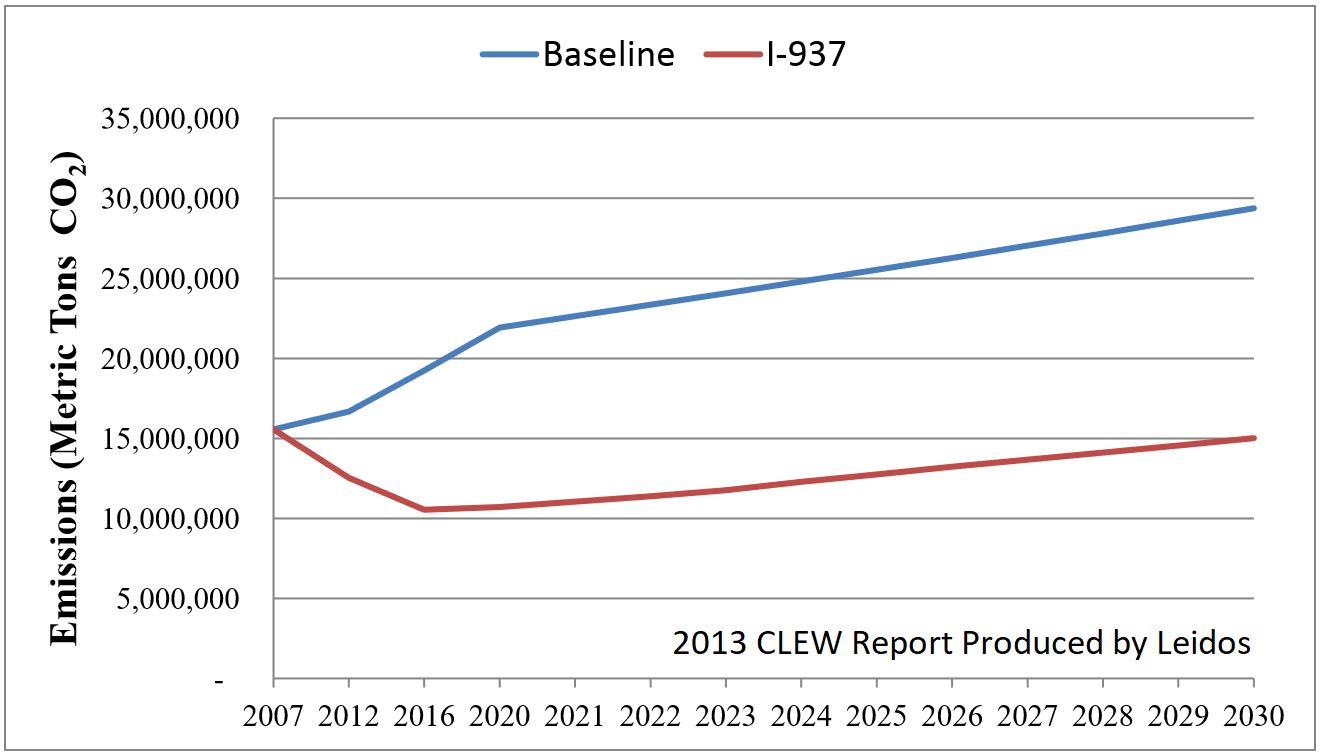
Chart 12 – Washington’s Climate Legislative Executive Workgroup (CLEW) identifies I-937 as the most impactful climate policy Washington has enacted.
In 2007 Washington State passed Initiative-937. This Renewable Portfolio Standard established a regulatory pricing mechanism focused on the electric sector. Utilities with greater than 25,000 customers are required by law to produce a certain percentage of their electricity from eligible renewable sources. Utilities have the option to either build and operate renewable energy production facilities, or they can purchase Renewable Energy Credits (REC’s) from a 3rd party that produced renewable energy and is willing to sell the associated environmental attributes. If a utility has more REC’s than required, they can sell excess REC’s on the open market. The price of REC’s changes over time with the supply and demand for eligible renewable energy.
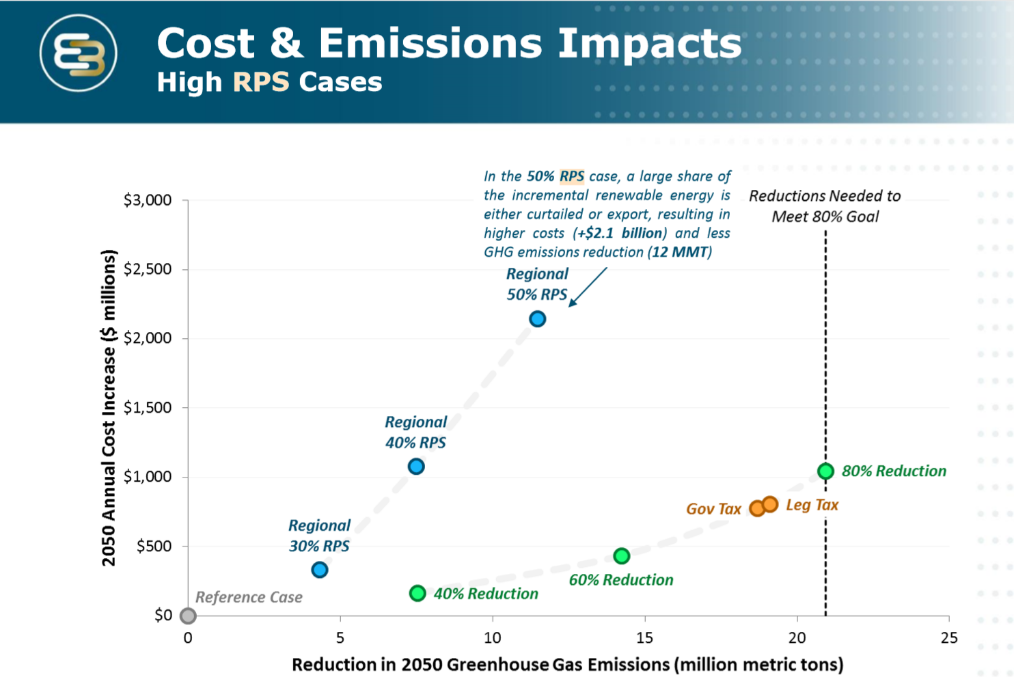
Chart 13 – Using a least cost planning method E3 compares the costs and carbon reduction benefits from either an idealized declining cap, a carbon tax, or a renewable portfolio standard.
Adding the trading mechanism allows the regulation to have similar economic efficiencies as a pure pricing mechanism that would cause the same integration of eligible renewable energy sources into those utilities’ portfolios. However, studies show that a technology agnostic carbon tax would reduce electric sector emissions substantially more, and at significantly lower cost, than an expansion of the Renewable Portfolio Standard. This is because there are lower cost ways to decarbonize the electric sector than to integrate more eligible renewable energy sources required by Washington’s Renewable Portfolio Standard. I-937 is technology specific, defining a few categories of “eligible” renewable energy for utilities to integrate into their power supply. In general, the more technology specific a policy is the less economically efficient its implementation will be.
Introduced during the 2018 Washington legislative session, a Low Carbon Fuel Standard is a similar regulatory pricing mechanism as an RPS, but targeting transportation fuels rather than electricity. HB 2338 would have required the carbon intensity (Carbon/Average Unit of Transportation Fuel) to decrease 10% by 2028. The regulated entities in this case are primarily the State’s fuel suppliers. Refineries have the option to either blend lower carbon biofuels into their retail sales, encourage more electrification of transportation, or purchase tradable credits from 3rd parties that have sold biofuels into Washington or created verified electrification of transportation. Again, the tradeable credit creates a pricing mechanism that allows compliance flexibility. This is a good thing as third parties can often deliver the desired outcome at a lower cost than the regulated entity. In contrast to the RPS, which specifies eligible renewable sources, HB 2338 was a fairly technology agnostic policy in that it sought to allow any biofuel, low carbon fuel, or electrification outcome to contribute to the reduction in overall transportation carbon intensity. By regulating the reduction in carbon rather than the integration of specific “eligible” technologies or fuel sources, the policy should have very similar economic efficiency as a pure pricing mechanism affecting transportation fuels. In general the more technology agnostic a policy is the more likely it is to approach the economic efficiency of a pricing mechanism that causes the same outcome.
Regulatory + Pricing Mechanism + Subsidy:
California’s Cap and Trade Program – AB32 is an example of all three policies blended together. It created a regulatory declining cap on annual carbon dioxide emissions in California. Regulated entities must purchase enough emission permits (also called allowances) at auction from the government to cover their annual emissions. As the cap declines, the supply of permits decreases and auction price increases creating a similar economic forcing factor as an escalating carbon tax.
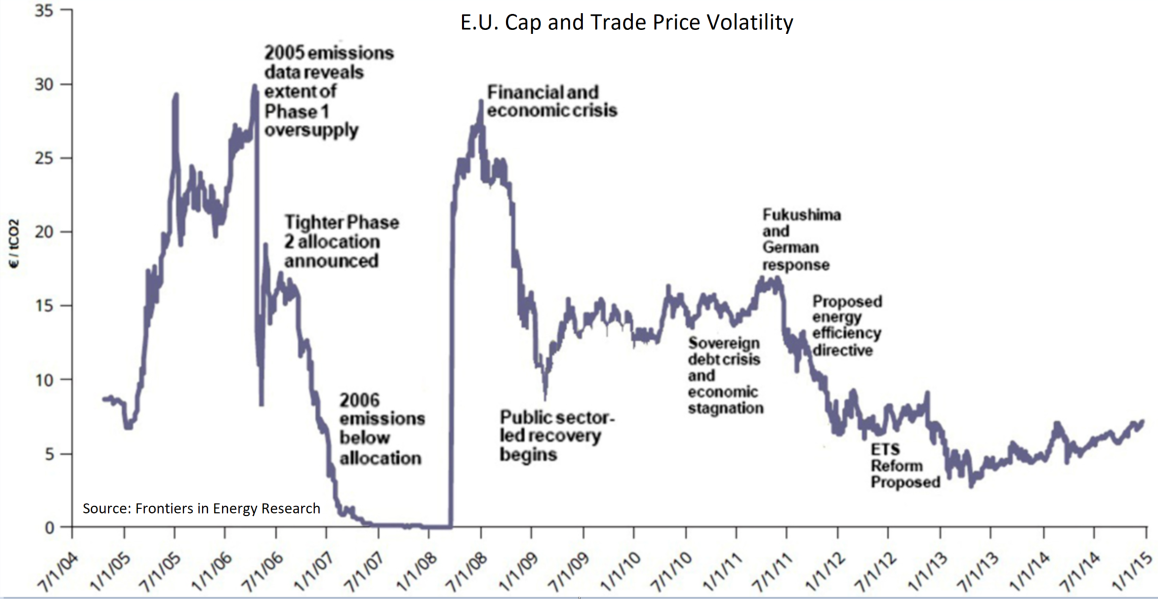
Chart 14 – The E.U. cap and trade marketplace faced violent volatility early in its life primarily due to an over allocation of grandfathered permits to existing emitters which drove permit prices to zero.
The advantage of cap and trade over a carbon tax is that it provides certainty in how much carbon dioxide emissions it will reduce. Its disadvantage is that it is price uncertain, and the price of emission permits can be highly volatile. If the cap is set above what the market normally would emit, or too many grandfathered permits are issued, the price of permits goes to zero. If the cap declines faster than companies can implement abatement technologies or adopt alternative energy sources, prices could skyrocket to whatever level is needed to bankrupt enough companies to reduce emissions. This is called demand destruction, and is not the goal of good climate policies which seek to smooth the transition to a prosperous low carbon economy, not eliminate emissions by decreasing total economic activity. The price volatility risk of cap and trade programs can be mitigated by adding price floors and ceilings on permit prices that preventing rapid or wide changes.
The third part of California’s Cap and Trade program, after regulating an emission decline trajectory and providing a pricing mechanism via tradable credits, is investing the revenue generated from the auction of emission permits into subsidy programs. California actually uses auction revenue for a wide variety of purposes, but a large portion of it is directed towards government run carbon reduction investment programs.
Pricing Mechanism + Subsidy
Washington’s 2018 failed Initiative -1631 is an example of a pricing mechanism + subsidy. This carbon fee and invest policy would have created a non-regulatory (reduction uncertain) escalating carbon fee (price certain) which would reduce carbon emissions the same way as a carbon tax. A fee differs from a tax in that all of the revenue it generates is legally bound to be spent addressing the problem upon which it was levied. In this case, revenue would have needed to be spent reducing carbon pollution or more broadly climate change risk. While some of the revenue from I-1631 would have been directed towards climate adaptation, the bulk of the funds were directed towards carbon reduction investments. These government run subsidy programs would have targeted acquiring carbon dioxide emission offsets and carbon sequestration credits.
Carbon Offsets and Sequestration
Carbon dioxide emission offsets are different than the emission permits purchased at auction or allocated to regulated entities under Cap and Trade programs. Emission offsets are created when an entity reduces the quantity of carbon pollution it would have otherwise emitted. For example, a program may provide a grant to an industrial facility planning to replace its boiler. Under normal economic practice it may plan to install an 85% efficient boiler, but with additional grant money it will instead install a 95% efficient boiler reducing its annual emissions. In contrast to a carbon tax which charges emitters for the pollution they create, purchasing emission offsets is paying an entity to pollute less than they normally would have under a business as usual scenario.
Emission offset programs can attempt to approach the economic efficiency of a pure pricing mechanism by being technology agnostic, transparent, and competitive with a focus on purchasing the lowest cost offsets on a $/ton basis. Subsidy programs focused on acquiring carbon offsets can create an expanded impact if they successfully leverage public funds by providing partial grants that enable projects that are primarily funded by private investments.
The challenge with carbon offset marketplaces is correctly assessing additionality. Additionality is the question of whether or not the carbon reduction activity would have occurred even without the grant. This question is even more difficult to answer when a carbon offset program is operating alongside an escalating carbon price that is constantly changing the cost-effectiveness of pollution reduction investments. While some policy overlap can occur causing a loss of economic efficiency, charging polluters for their carbon emissions and then using the revenue generated to pay polluters to make investments that further reduce their emissions maximizes total carbon reductions possible for any specific carbon price.
Carbon sequestration credits like the federal 45Q policy covering power plant and industrial carbon capture and storage or California’s biosequestration forestry protocols are both uniquely different than carbon emission offsets, but unfortunately often are co-mingled together in carbon reduction investment programs. Rather than paying a polluter to pollute less, carbon sequestration credits pay an entity to absorb carbon dioxide out of the atmosphere, or smoke stack, and then store that carbon on the planet for some period of time. While a grant program promoting biosequestration activities like cover cropping, no-till agriculture, or afforestation would be a subsidy program, a pure pricing mechanism policy could also be designed to pay for a specific biosequestration activities on a performance basis. For example, a policy could establish an annual financial reward for the storage of carbon dioxide previously in the atmosphere, creating a positive pricing mechanism.
Paired with a carbon tax, this pure but dual effect pricing mechanism would financially incentivize both the reduction of emissions and the enhancement of carbon dioxide absorption and storage. The carbon tax applied to all current emitters internalizes the cost of polluting. The sequestration credit applied to all current entities storing carbon in trees and soil internalizes the environmental benefits rural landscapes provide society.
By adding value to rural working and preservation forests, and well managed soils this policy would slow deforestation while encouraging afforestation and better land management. Washington currently emits more carbon dioxide emissions than we sequester, so this type of dual effect pricing mechanism would create a net increase in revenue. That excess revenue could be used to reduce other taxes, or fund items that would have otherwise required a tax increase making it a pure dual effect pricing mechanism. Alternatively, the excess revenue could be directed towards carbon reduction subsidy programs to maximize the total reduction of atmospheric carbon dioxide.
Conclusion:
While the highly politicised climate policy world can be confusing, it is helpful to break down the many different policy options and proposals into their functional parts. In general, all polices integrate some combination of pricing mechanisms, regulations, and subsidies. No one approach is universally better than the other, each having notable strengths and weaknesses. In a technocratic paradise, a pure escalating carbon tax would likely be the economists’ weapon of choice against the grave threat of climate change. While pricing mechanisms offer the greatest flexibility and economic efficiency, their achilles heel is a lack of popularity. That popularity challenge grows even greater at the price levels actually high enough to meet necessary climate change targets. Regulations, subsidies, and hybrid policies are an important way to make forward progress towards implementing effective policies that will accelerate our transition to a prosperous low carbon future.
About the Author: Greg Rock is a regular contributor to the Clean & Prosperous Institute. He has a master’s degree in sustainable energy engineering and an entrepreneurial background with ventures focused on green cars and transit orientated infill development. Greg worked for three years at the State Energy Office, stays active in climate policy, sits on the Clean Tech Alliance policy committee, and serves on the boards of: Carbon Washington, Audubon Washington, and Southfork Resources, Inc.
Greg Rock is a regular contributor to the Clean & Prosperous Institute. He has a master’s degree in sustainable energy engineering and an entrepreneurial background with ventures focused on green cars and transit orientated infill development. Greg worked for three years at the State Energy Office, stays active in climate policy, sits on the Clean Tech Alliance policy committee, and serves on the boards of: Carbon Washington, Audubon Washington, and Southfork Resources, Inc.
